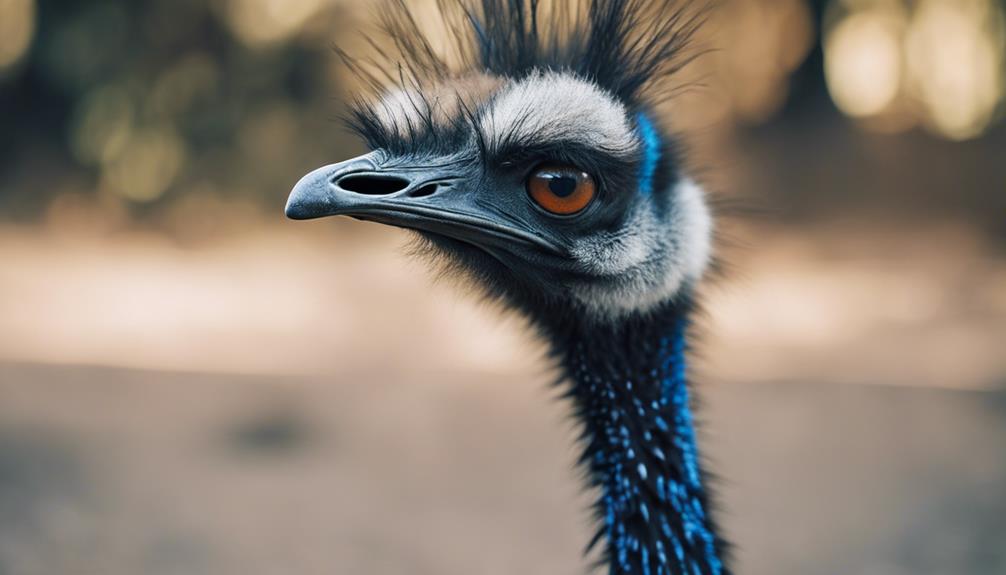
As you observe the graceful yet robust appearance of emus, you might wonder, what sets them apart from other flightless birds? Their anatomy holds secrets that define their uniqueness in the avian world.
From their towering bodies to the intricacies of their respiratory system, emus harbor adaptations that intrigue scientists and enthusiasts alike. But what truly distinguishes these enigmatic creatures?
Stay tuned to uncover the fascinating details that make emus a marvel of evolution.
Key Takeaways
- Emus possess specialized physical features like long necks and powerful legs for optimal foraging and defense.
- Their body size and adaptations enable rapid growth, agility, and efficient habitat adaptation.
- The unique leg structure with strong muscles and three-toed feet supports swift movement exceeding 30 miles per hour.
- Emus exhibit distinctive reproductive anatomy and behaviors, including internal fertilization and male egg incubation.
Physical Features
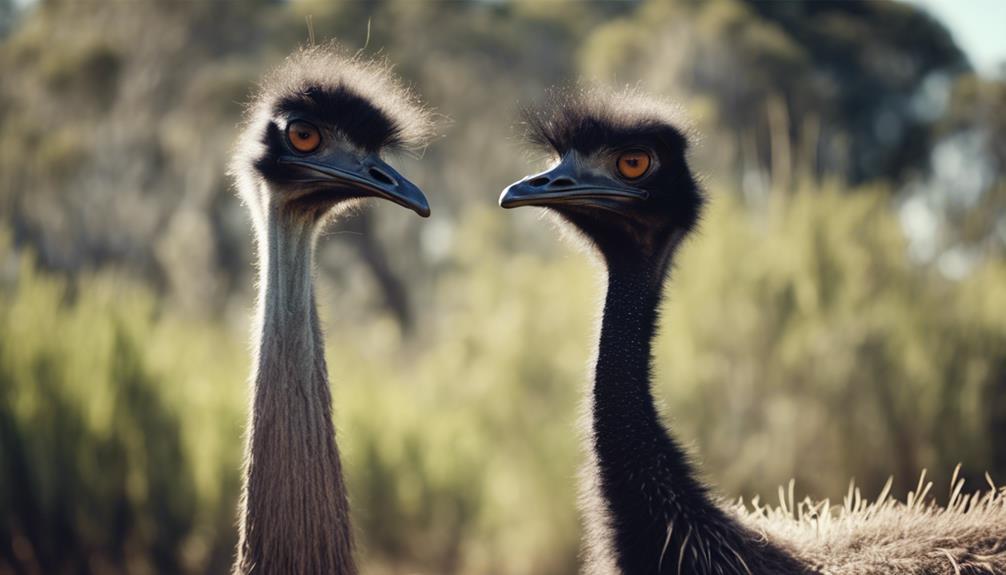
Emus possess distinct physical characteristics that distinguish them from other flightless birds, such as their long necks and powerful legs. Their feathers play a crucial role in regulating body temperature and providing protection. Emus molt annually, shedding old feathers to make way for new ones, ensuring optimal insulation and protection.
The beak of an emu is uniquely designed for feeding and defense. It's pointed and sturdy, allowing them to forage efficiently for fruits, seeds, and insects. Their eyes are large and provide excellent vision, aiding in detecting predators and finding food sources. Emus have a keen sense of sight that's essential for their survival in the wild.
Observing an emu up close reveals intricate details in their physical features. The way their feathers glisten in the sunlight and how their beak adeptly picks up small objects are marvels of nature. Understanding these characteristics gives insight into the evolutionary adaptations that have shaped these fascinating creatures.
Large Body Size
A notable characteristic of the emu species is their substantial body size, a trait that distinguishes them within the avian world. Emus exhibit a robust and muscular build, contributing to their impressive stature. From hatching, emus undergo rapid growth, reaching adult heights of up to 6.2 feet (1.9 meters) and weighing between 88 to 132 pounds (40 to 60 kilograms) on average. This accelerated growth allows them to swiftly develop the strong skeletal structure necessary to support their size.
Their muscular build aids in various activities essential for survival, such as foraging for food and defending against predators. Emus rely on their muscular bodies to navigate their environments efficiently, showcasing agility despite their size. The combination of their large body size and muscularity grants them a unique advantage in the wild, enabling them to thrive in diverse habitats ranging from open plains to dense forests. Emus' impressive physique is a testament to their evolutionary adaptations that have allowed them to become one of the largest bird species on the planet.
Powerful Legs
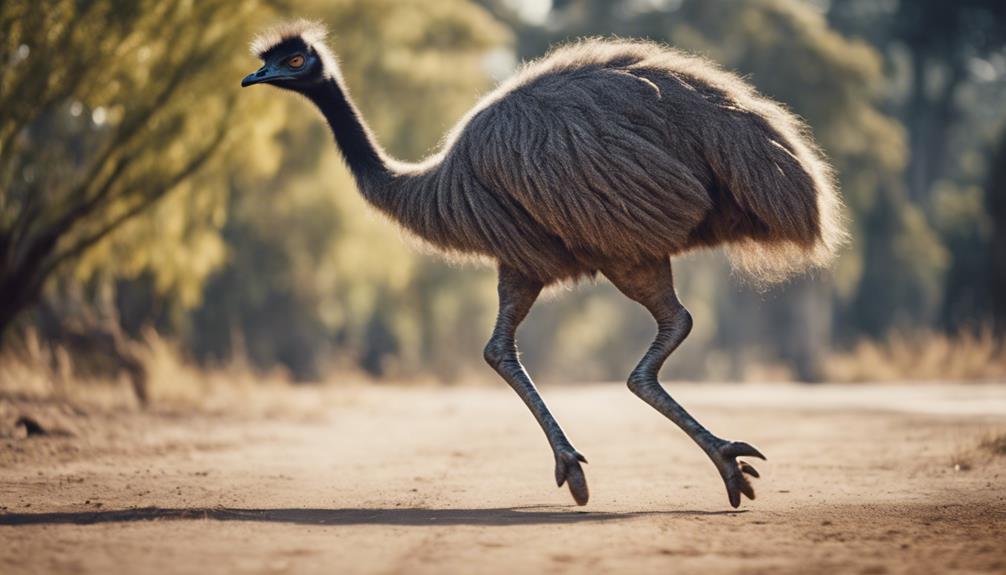
How do the anatomy of emus contribute to the development of their powerful legs?
Emus possess a unique muscular build that plays a crucial role in their exceptional running speed. These birds have long, strong legs that are perfectly adapted for swift movement across varied terrains. The powerful muscles in their legs, particularly the thigh and calf muscles, provide the necessary strength for propulsion and endurance during their fast sprints.
Emus' muscular legs are designed to support their large bodies and enable them to reach impressive speeds, often exceeding 30 miles per hour. Their leg bones are aligned in a way that maximizes efficiency during each stride, allowing them to cover vast distances with minimal energy expenditure. The tendons and ligaments in their legs act as powerful springs, storing and releasing energy with each step, further enhancing their running capabilities.
Three-Toed Feet
The unique anatomy of emus extends to their three-toed feet, which play a vital role in their overall mobility and balance. Emus possess a specialized foot structure that's crucial for their distinctive style of locomotion.
Here are some key points to consider:
- Foot Structure: Emus have three toes on each foot, with each toe ending in a sharp claw. This design helps in distributing their weight efficiently and provides stability during movement.
- Locomotion: The three-toed feet of emus are well-suited for their fast running speeds and agile maneuvers. The toes act as a spring mechanism, aiding in propulsion and shock absorption.
- Toes: The arrangement of three toes allows emus to adapt to various terrains, from soft sand to rocky surfaces, enabling them to navigate diverse environments with ease.
- Adaptations: Over time, emus have evolved these unique feet to optimize their running capabilities, making them well-adapted for both speed and agility in the wild.
Emus' three-toed feet are a remarkable example of evolutionary specialization, perfectly honed for their survival in the Australian landscape.
Absence of Keel Bone
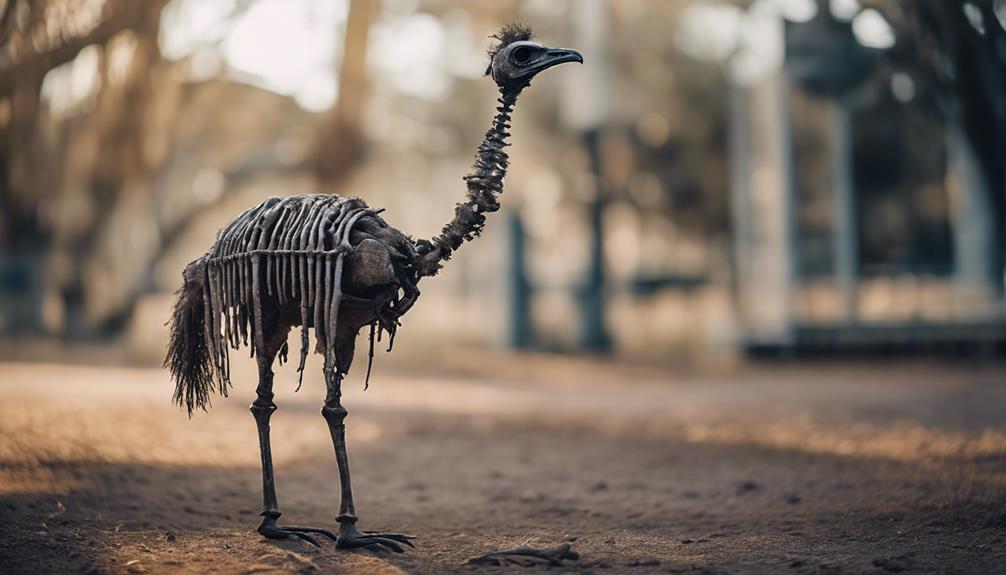
Emus exhibit a notable absence of a keel bone, a feature that distinguishes them from many other bird species. This lack of a keel bone is a characteristic trait of flightless birds, including the emu. The keel bone is a large ridge on the sternum to which flight muscles are attached in birds capable of sustained flight. Since emus are flightless, they don't require this structure for the attachment of flight muscles.
The absence of a keel bone in emus plays a crucial role in their survival strategies. Without the need for powerful flight muscles, emus have evolved to distribute their weight differently, allowing them to excel in running at high speeds when needed. This adaptation enables emus to escape predators and navigate their habitats effectively. The sturdy, powerful legs of emus, combined with their unique weight distribution due to the absence of a keel bone, contribute to their remarkable agility and endurance in the wild.
Long Neck
In flightless birds like emus, the absence of a keel bone is compensated by their remarkable adaptation of a long neck, which serves multiple functional purposes in their survival strategies. Emus have evolved a notably flexible neck that aids them in various aspects of their lives, particularly in their feeding behavior.
Here are some key points to consider about the emu's long neck:
- Foraging Efficiency: The emu's long neck allows it to reach a wide range of vegetation, enhancing its ability to find food in different environments.
- Predator Detection: The flexibility of the emu's neck enables it to scan its surroundings more effectively, helping to detect potential threats and predators.
- Thermoregulation: By extending or retracting its neck, the emu can regulate its body temperature, a crucial adaptation in fluctuating environmental conditions.
- Communication: Emus use their necks not only for feeding but also for social interactions, displaying dominance or submission through various neck postures and movements.
Emus have truly harnessed the power of their long necks to thrive in their environments, showcasing the marvels of evolutionary adaptation.
Small Wings
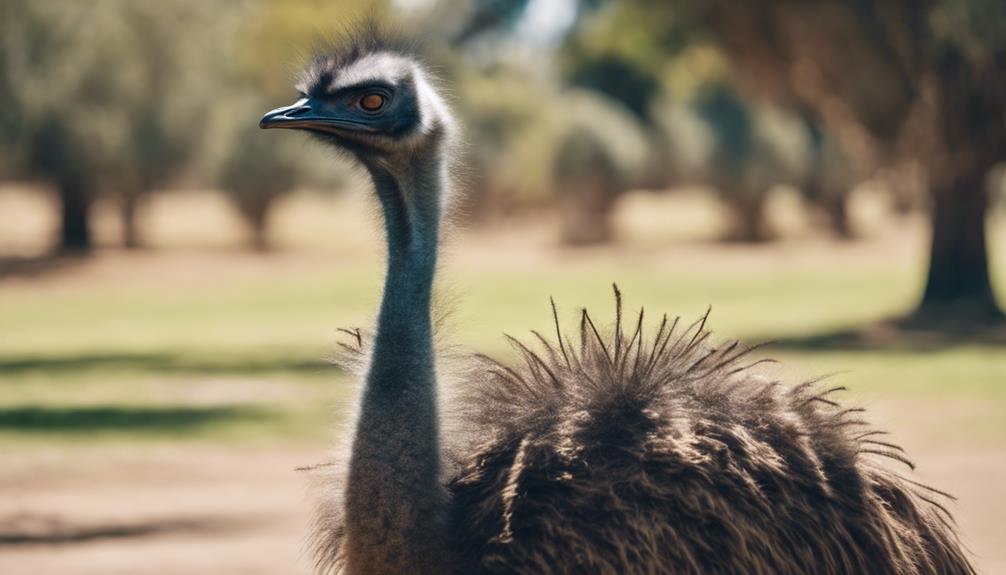
With relatively underdeveloped flight capabilities, emus possess wings that are noticeably small compared to their body size. Emu wings exhibit a simplified wing structure, consisting of primary and secondary feathers attached to a reduced skeletal framework. These wings lack the necessary adaptations for sustained flight, indicating a diminished flight capability in emus.
The evolutionary purpose of these small wings lies in their adaptation to a terrestrial lifestyle. Over time, emus have evolved to prioritize ground mobility over aerial prowess, rendering their wings a vestigial feature. Despite their inability to fly, emus utilize their wings for balance, communication, and even as a form of display during courtship rituals.
Observing the size and structure of emu wings provides insight into the species' unique evolutionary path and ecological niche. These small wings are a testament to the adaptability of emus in diverse environments, showcasing the fascinating interplay between form and function in the natural world.
Feathers and Coloration
Exhibiting a striking array of hues and intricate patterns, the feathers of emus play a crucial role in both insulation and communication within their environment. Emus possess a unique combination of features when it comes to their feathers. Here's what makes them stand out:
- Iridescent Feathers: Emus have specialized feathers that exhibit iridescence, reflecting a stunning array of colors when viewed from different angles. This iridescence is especially prominent during mating displays, adding to the visual spectacle of courtship.
- Camouflage Colors: The coloration of emu feathers serves a dual purpose. Their brown and grey tones help them blend seamlessly into their natural surroundings, providing effective camouflage from predators. At the same time, these colors also aid in temperature regulation by absorbing or reflecting sunlight as needed.
- Communication through Plumage: Beyond their functional roles, emu feathers are also integral to communication within the species. During displays of dominance or courtship, the vibrancy and posture of their feathers convey intricate messages to other emus.
- Seasonal Molt Patterns: Emus undergo molting cycles where old feathers are shed and replaced with new ones. These molting patterns are essential for maintaining feather quality and ensuring optimal insulation throughout the year.
Unique Respiratory System
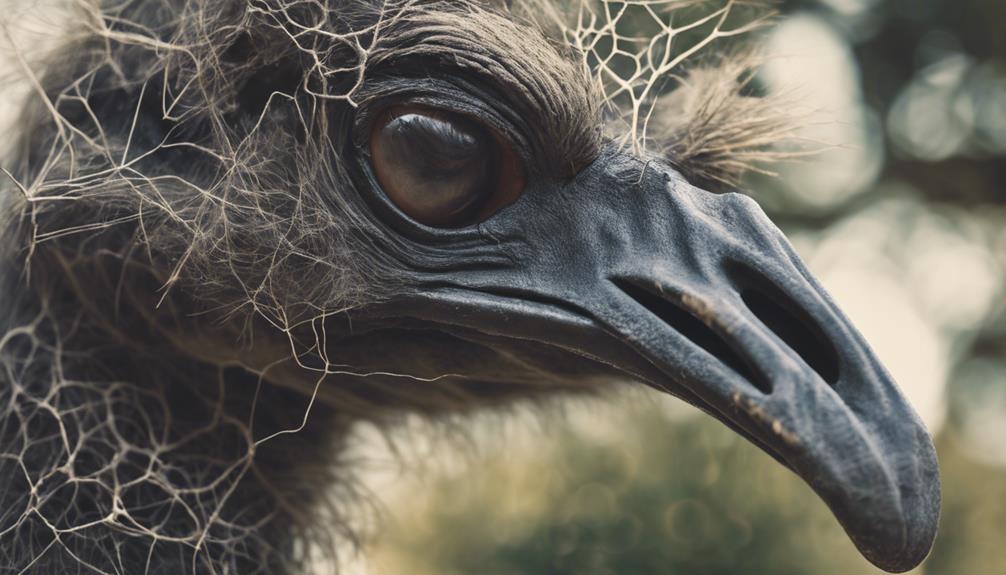
Emus are distinct from other birds due to their unique respiratory system, which is essential for their survival in their varied habitats. One of the most remarkable features of an emu's respiratory system is its air sacs. These air sacs play a crucial role in providing efficient oxygenation to their large bodies, allowing them to thrive in diverse environments. Emus have a sophisticated system of air sacs that extend into their bones, providing them with an extra respiratory surface for improved oxygen exchange. This adaptation is particularly beneficial during their high-energy activities such as running at impressive speeds.
Moreover, emus possess a specialized diaphragmatic muscle that aids in their breathing process, enabling them to regulate airflow more effectively. This unique adaptation allows emus to maintain a steady oxygen supply, especially during strenuous activities like mating dances or predator evasion. In conclusion, the emu's respiratory system showcases a set of distinct and remarkable adaptations that contribute significantly to their survival in various habitats.
Adaptations for Survival
Survival in diverse environments necessitates emus to adapt their physical features and behaviors for optimal functioning. Emus have evolved remarkable evolutionary strategies to thrive in their preferred habitats. Here are some key adaptations that contribute to their survival:
- Specialized Feathers: Emus possess double-shafted feathers that provide insulation in cold climates and help regulate body temperature in hot environments.
- Long Legs: Their elongated legs aid in swift running, allowing emus to escape predators and cover large distances to find food and water.
- Powerful Feet: Emus have strong, three-toed feet with sharp claws that help them defend against threats and forage for food in various terrains.
- Excellent Eyesight: With keen eyesight, emus can spot predators from afar and navigate their surroundings effectively based on their habitat preferences.
These adaptations showcase how emus have finely tuned their physical attributes over time to suit the challenges of their environments, ensuring their survival and success in the wild.
Reproductive Anatomy
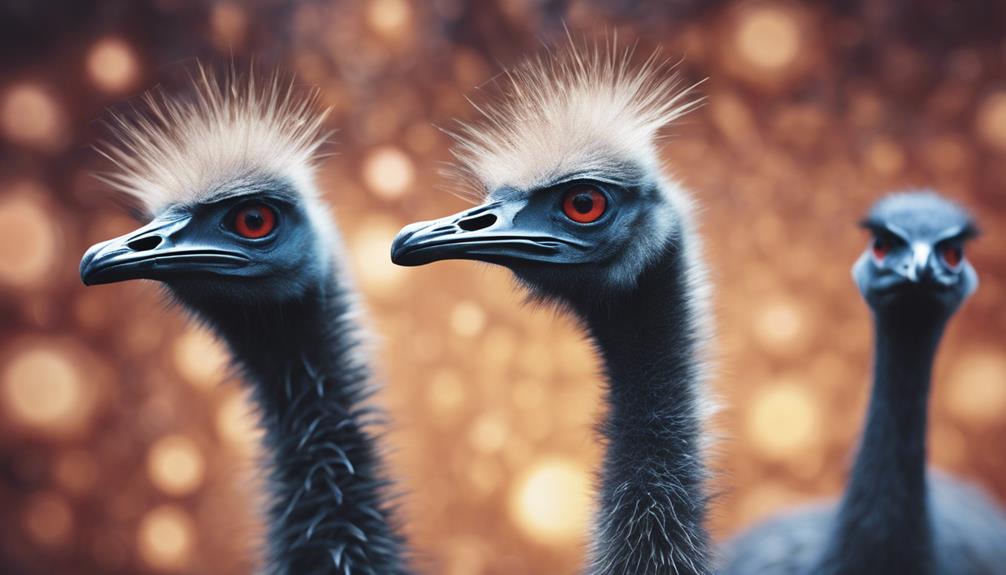
An understanding of the reproductive anatomy of emus provides insights into their unique physiological mechanisms for breeding success and continuation of their species. Emus, like other birds, have internal fertilization. The male emu's reproductive system includes testes that produce sperm, which are then transferred to the female through a specialized cloacal kiss during mating. The female emu, on the other hand, has ovaries where the ova develop. Once fertilization occurs, the egg begins its formation journey.
Interestingly, emus are known for their remarkable egg-laying process. The female emu lays large, dark-green eggs that weigh around 1-1.5 kilograms, making them some of the largest eggs relative to body size among birds. These eggs are then incubated by the male emu, who takes on the responsibility of keeping them warm and safe until they hatch. This unique division of labor in incubation showcases the intricate reproductive behaviors that contribute to the survival and success of the emu species.
Behavioral Characteristics
Observing the emus' behavioral characteristics provides valuable insights into their social interactions and adaptation strategies within their natural environment. Emus exhibit fascinating behaviors that shed light on their unique way of life. Here are some key aspects to consider:
- Social Interactions: Emus are social birds that often travel in pairs or small groups. They engage in various social behaviors like preening each other and vocalizing to communicate.
- Mating Rituals: During the breeding season, male emus perform elaborate mating rituals to attract females. This includes puffing up their feathers, emitting deep booming sounds, and performing a dance to impress potential mates.
- Foraging Behavior: Emus are opportunistic feeders and use their sharp beaks to forage for a variety of plant matter, insects, and small vertebrates. They've a keen sense of smell to detect food sources.
- Communication Signals: Emus communicate through a range of vocalizations, body postures, and movements. They use different signals to convey alarm, mating readiness, or to maintain group cohesion.
Frequently Asked Questions
How Fast Can Emus Run and What Makes Them Such Fast Runners?
You're curious about emus' speed and what makes them swift runners. Emus can hit speeds up to 30 mph due to their biomechanics. Their long legs, powerful muscles, and unique limb structure give them evolutionary advantages and exceptional endurance characteristics.
Do Emus Have Any Natural Predators in Their Native Habitat?
In their native habitat, emus have faced various natural predators, shaping their predation dynamics and evolutionary adaptations. Ecological interactions with dingoes and eagles influence their behavioral defenses, such as vigilance and fast running speeds.
What Is the Average Lifespan of an Emu in the Wild?
In the wild, emus typically live around 10-20 years. Factors like reproduction cycles, population dynamics, and environmental conditions influence their longevity. With a life full of challenges, these majestic birds embody resilience.
How Do Emus Communicate With Each Other and What Types of Vocalizations Do They Make?
Emus communicate through a variety of vocalizations and body language. Their social interactions involve calls, drumming sounds, and soft grunts. They use these communication signals to express dominance, attract mates, warn of danger, and maintain group cohesion.
Are There Any Cultural or Symbolic Meanings Associated With Emus in Indigenous Australian Cultures?
In Indigenous Australian cultures, emus embody profound symbolism and significance, representing connection to land, spirituality, and ancestral wisdom. Through their majestic presence, emus carry rich narratives and beliefs that resonate deeply.
Conclusion
So there you have it, the fascinating anatomy of emus! From their large body size to their powerful legs and unique respiratory system, these birds are truly a marvel of nature.
With their three-toed feet and absence of a keel bone, emus have adapted perfectly for survival. And let's not forget their reproductive anatomy and behavioral characteristics, which only add to their charm.
Next time you see an emu, remember all the amazing features that make them so special!




